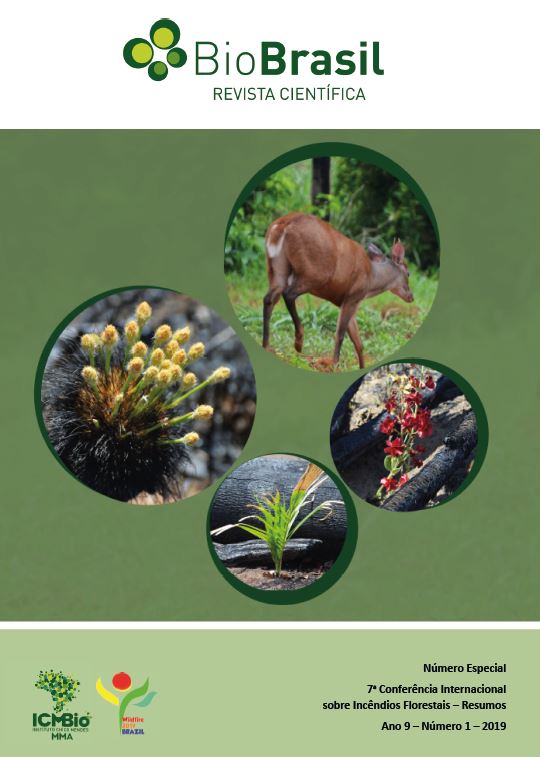Fire protection associations as a collaborative mechanism for a landscape-based approach to integrated fire management for reducing haze and greenhouse gas emissions in Indonesia
DOI:
https://doi.org/10.37002/biodiversidadebrasileira.v9i1.1256Palavras-chave:
Fire Protection Associations, collaboration, integrated wildfire management, IndonesiaResumo
Internationally Fire Protection Associations (FPAs) have emerged as an effective structure for wildfire management. It serves as a basis to formalize collaboration between stakeholders across landscapes from which Integrated Fire Management (IFM) best practice can be applied. Fire is also a critical element in terms of shaping as well as maintaining landscapes, as many South East Asian forest types are of pyrogenic origin. In the Indonesian context, disastrous fires resulting from poor peat landscape management, in the 2015 season alone, caused 2.6 million hectares of land to burn. It cost Indonesia an estimated USD 16.1 billion (IDR 221 trillion) equivalent to 1.9 percent of 2015 GDP. Haze has also contributed to the death of 19 people and more than 500,000 cases of acute respiratory infections. Immediate health costs totaled USD 151 million. Around 15.95 million tons of CO2 emissions were released into the atmosphere per day. About 33 percent of the total area burned was peatland, leading to noxious haze that blanketed parts of Indonesia and the region, disrupting transport, trade, and tourism, forcing school closures and negatively affecting health. In the immediate response to the unfolding 2015 disaster, over USD 300 million was spent on aerial firefighting aircraft and 22 000 military and police troops were mobilised to fight the fires. Unfortunately, without adequately trained and equipped ground forces, applying appropriate strategy and tactics to compliment the aircraft and, lacking the required coordination and command structures for ground and aerial fire suppression operations, these responses did not have optimal effect. Recent insights in peat fire behaviour, underline the need for a collaborative and more integrated formal approach to peat wildfires by revealing the various fire transition phases. Hence the importance of effective Integrated Fire Management applied through a formal collaboration mechanism which has become known as Fire Protection Associations (FPAs) or also called Klasters in Indonesia. The following aspects will be covered: What is a Fire Protection Association, Role and functions of FPA's; Funding of FPA's; Role and functions of the Provincial and National FPA's; Establishing FPA's in Indonesia as a most recent example
Downloads
Referências
See: A Guide to Integrated Fire Management: Establishing Fire Protection Associations in South Africa. In d. o. Working on Fire. The Western Cape Provincial Disaster Management Fire Working Group. Fynbos Fire Project. (2016)
See: Karki, Sameer (2002). Community Involvement in and Management of Forest Fires in South East Asia
The Cost of Fire, An Economic Analysis of Indonesia's 2015 Fire Crisis, Wold Bank Group February 2016.
Various news reports at the time: https://www.theguardian.com/world/2015/oct/26/indonesias-fires-crime-against-humanity-hundreds-of-thousands-suffer
http://www.climatechangenews.com/2016/09/19/indonesias-2015-fires-killed-100000-people-study-finds/
A guide to Integrated Fire Management (Fynbos Fire Project, 2016).
Oosthuizen, Wilson, & Conradie, Integrated Fire Management presentatons to various Indonesian stakeholders, 2015.
FAO, Fire management: voluntary guidelines. Principles and strategic actions, 2006.
Rangeland Fire Protection Associations: An Alternative Model for Wildfire Response; Emily Jane Davis, Jesse Abrams, Katherine Wollstein, Alethea Steingisser, James E. Meacham (2017). Ecosystem Workforce Programme Working Paper no 80, University of Oregon, Oregon State University, Joint fire science programme.
UNOPS, GIZ, & WoF. (2016). Wildfire prevention preparedness and response: A report on a study tour to South Africa undertaken by Indonesian government and stakeholders, 21 - 29 August 2016. Government of Indonesia, UNOPS, GIZ and Working on Fire.
The Moorland Association Briefing Notes: The moorlands, grouse, fire and floods (2016).Moors
Re-burn phenomena in wildland fire fighting operations in commercial forestry plantations on peat soils in South Sumatra, Indonesia. T Wilson, Working on Fire International (2016).
Cochrane MA. Fire science for rainforests. Nature. 2003.
Cochrane M A, Alencar A, Schulze M D, Souza C M Jr, Nepstad D C, Lefebvre P and Davidson E, Positive feedbacks in the fire dynamic of closed canopy tropical forests. Science. 1999
Combustion and thermal characteristics of peat firein tropical peatland in Central Kalimantan, Tropics, Vol.14, pp. 1-19. Usup, A., Hashimoto, Y., Takahashi, H. and Hayasaka, H. 2004.
A Guide to Integrated Fire Management: Establishing Fire Protection Associations in South Africa. In d. o. Working on Fire. The Western Cape Provincial Disaster Management Fire Working Group. Fynbos Fire Project. (2016).
Downloads
Publicado
Edição
Seção
Licença
Copyright (c) 2021 Biodiversidade Brasileira - BioBrasil

Este trabalho está licenciado sob uma licença Creative Commons Attribution-NonCommercial-NoDerivatives 4.0 International License.
Os artigos estão licenciados sob uma licença Creative Commons Atribuição-NãoComercial-SemDerivações 4.0 Internacional (CC BY-NC-ND 4.0). O acesso é livre e gratuito para download e leitura, ou seja, é permitido copiar e redistribuir o material em qualquer mídia ou formato.











